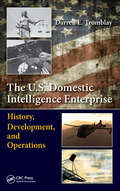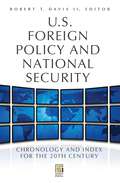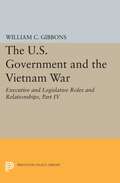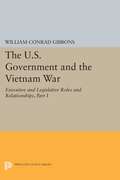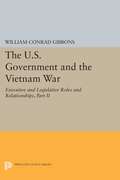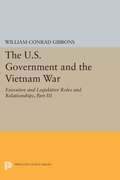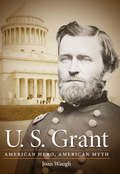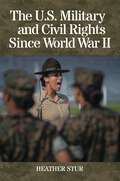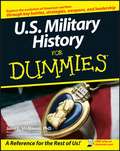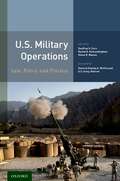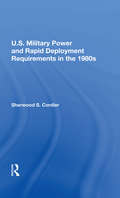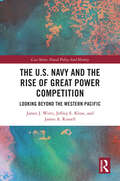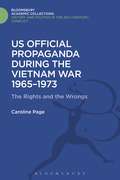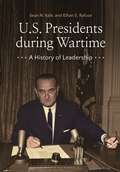- Table View
- List View
U.S. Civil War Battle by Battle
by Iain MacGregor'Just the thing for US Civil War buffs: snappily written, informative and entertaining. A cracking read.' Saul David, bestselling author and historianThis attractively packaged gift book offers a highly illustrated introduction to some of the U.S. Civil War's most famous and important battles, from the Battle of Fort Sumter in 1861 to the Battle of Appomatox Court House in 1865.The U.S. Civil War was the most cataclysmic military struggle of the late 19th century, and in four bloody years of fighting from 1861 to 1865 over 620,000 American soldiers and sailors lost their lives in more than 8,000 battles, engagements and skirmishes. U.S. Civil War Battle by Battle tells the story of 30 of the most significant of these battles. These include some of the most famous clashes, such as the battles of Gettysburg and Fredericksburg, which resonate through American military history, but also the less well known, such as the battles of Brandy Station and Cedar Creek. This highly illustrated introduction, packed full of colour artwork, covers every theatre of the war and details infantry, cavalry, artillery and seaborne units from both the Union and the Confederate forces to give a true sense of the scale of the War between the States.
The U.S. Domestic Intelligence Enterprise: History, Development, and Operations
by Darren E. TromblayMuch has been written about U.S. intelligence operations. However, intelligence, as it is conducted in the U.S. domestic environment, has usually been treated in a fractured and sensationalistic manner. This book dispassionately assesses the U.S. domestically oriented intelligence enterprise by first examining its individual components and then sho
U.S. Foreign Policy and National Security [2 volumes]: Chronology and Index for the 20th Century [2 volumes] (Praeger Security International)
by Robert T. IIThis comprehensive guide provides an in-depth, chronological overview of issues and policy processes related to U.S. foreign, military, and national security policy during the 20th century.U.S. Foreign Policy and National Security: Chronology and Index for the 20th Century provides a unique compilation of data never before combined in a single volume. Key events and policy meetings are arranged in order by presidential administration, from the McKinley administration to that of President Obama. Each section begins with a concise list of policymakers, including Cabinet-level officials, members of the National Security Council, and senior ranks of the Department of State and Department of Defense, supplemented with bibliographic data. The bulk of each chapter is comprised of detailed lists of meetings of the president of the United States with key advisors and foreign dignitaries. These meetings include international conferences, meetings between the president and foreign leaders, meetings of the joint chiefs of staff in World War II, and meetings of the National Security Council since its creation in 1947. This unprecedented guide will be invaluable to researchers and, indeed, to anyone interested in the decisions that determined the course of U.S. history.
The U.S. Government and the Vietnam War: July 1965-January 1968
by William Conrad GibbonsThis fourth volume of a five-part policy history of the U.S. government and the Vietnam War covers the core period of U.S. involvement, from July 1965, when the decision was made to send large-scale U.S. forces, to the beginning of 1968, just before the Tet offensive and the decision to seek a negotiated settlement. Using a wide variety of archival sources and interviews, the book examines in detail the decisions of the president, relations between the president and Congress, and the growth of public and congressional opposition to the war. Differences between U.S. military leaders on how the war should be fought are also included, as well as military planning and operations.Among many other important subjects, the financial effects of the war and of raising taxes are considered, as well as the impact of a tax increase on congressional and public support for the war. Another major interest is the effort by Congress to influence the conduct of the war and to place various controls on U.S. goals and operations. The emphasis throughout this richly textured narrative is on providing a better understanding of the choices facing the United States and the way in which U.S. policymakers tried to find an effective politico-military strategy, while also probing for a diplomatic settlement.Originally published in 1995.The Princeton Legacy Library uses the latest print-on-demand technology to again make available previously out-of-print books from the distinguished backlist of Princeton University Press. These editions preserve the original texts of these important books while presenting them in durable paperback and hardcover editions. The goal of the Princeton Legacy Library is to vastly increase access to the rich scholarly heritage found in the thousands of books published by Princeton University Press since its founding in 1905.
The U.S. Government and the Vietnam War: 1945-1960
by William Conrad GibbonsThis searching analysis of what has been called America's longest war" was commissioned by the Senate Committee on Foreign Relations to achieve an improved understanding of American participation in the conflict. Part I begins with Truman's decision at the end of World War II to accept French reoccupation of Indochina, rather than to seek the international trusteeship favored earlier by Roosevelt. It then discusses U.S. support of the French role and U.S. determination to curtail Communist expansion in Asia.Originally published in 1986.The Princeton Legacy Library uses the latest print-on-demand technology to again make available previously out-of-print books from the distinguished backlist of Princeton University Press. These editions preserve the original texts of these important books while presenting them in durable paperback and hardcover editions. The goal of the Princeton Legacy Library is to vastly increase access to the rich scholarly heritage found in the thousands of books published by Princeton University Press since its founding in 1905.
The U.S. Government and the Vietnam War: 1961-1964
by William Conrad GibbonsThis searching analysis of what has been called America's longest war" was commissioned by the Senate Committee on Foreign Relations to achieve an improved understanding of American participation in the conflict. Part II covers the period from Kennedy's inauguration through Johnson's first year in office.Originally published in 1986.The Princeton Legacy Library uses the latest print-on-demand technology to again make available previously out-of-print books from the distinguished backlist of Princeton University Press. These editions preserve the original texts of these important books while presenting them in durable paperback and hardcover editions. The goal of the Princeton Legacy Library is to vastly increase access to the rich scholarly heritage found in the thousands of books published by Princeton University Press since its founding in 1905.
The U.S. Government and the Vietnam War: 1965-1966
by William Conrad GibbonsPart III, which begins in January 1965 and ends in January 1967, treats the watershed period of U.S. involvement in the war, from President Johnson's decision to bomb North Vietnam and to send U.S. ground forces into South Vietnam, through the buildup of military forces and political cadres required by the new U.S. role in the war. This volume examines Johnson's policymaking, his interaction with military advisors and with Congressional critics such as Mike Mansfield, and his reactions as protests against the war began to grow.Originally published in 1989.The Princeton Legacy Library uses the latest print-on-demand technology to again make available previously out-of-print books from the distinguished backlist of Princeton University Press. These editions preserve the original texts of these important books while presenting them in durable paperback and hardcover editions. The goal of the Princeton Legacy Library is to vastly increase access to the rich scholarly heritage found in the thousands of books published by Princeton University Press since its founding in 1905.
U. S. Grant: American Hero, American Myth (Civil War America)
by Joan WaughAt the time of his death, Ulysses S. Grant was the most famous person in America, considered by most citizens to be equal in stature to George Washington and Abraham Lincoln. Yet today his monuments are rarely visited, his military reputation is overshadowed by that of Robert E. Lee, and his presidency is permanently mired at the bottom of historical rankings.In an insightful blend of biography and cultural history, Joan Waugh traces Grant's shifting national and international reputation, illuminating the role of memory in our understanding of American history. Using a wide range of written and visual sources--newspaper articles, private and public reminiscences, photographs, paintings, cartoons, poetry, and much more--Waugh reveals how Grant became the embodiment of the American nation in the decades after the Civil War. She does not paper over Grant's image as a scandal-ridden contributor to the worst excesses of the Gilded Age. Instead, she captures a sense of what led nineteenth-century Americans to overlook Grant's obvious faults and hold him up as a critically important symbol of national reconciliation and unity. Waugh further shows that Grant's reputation and place in public memory closely parallel the rise and fall of the northern version of the Civil War story--in which the United States was the clear, morally superior victor and Grant was the symbol of that victory. By the 1880s, Waugh shows, after the failure of Reconstruction, the dominant Union myths about the war gave way to a southern version that emphasized a more sentimental remembrance of the honor and courage of both sides and ennobled the "Lost Cause." During this social transformation, Grant's public image changed as well. By the 1920s, his reputation had plummeted.Most Americans today are unaware of how revered Grant was in his lifetime. Joan Waugh uncovers the reasons behind the rise and fall of his renown, underscoring as well the fluctuating memory of the Civil War itself.
U.S. Marines and Amphibious Warfare
by Jeter A. Isely Philip A. Crowl"Not only a just appraisal of the campaigns waged by Marines in World War II; it is a documentation of the Marine struggle to prove the feasibility of amphibious warfare.... Relentlessly accurate and impartial." —N.Y. Times.Originally published in 1951.The Princeton Legacy Library uses the latest print-on-demand technology to again make available previously out-of-print books from the distinguished backlist of Princeton University Press. These editions preserve the original texts of these important books while presenting them in durable paperback and hardcover editions. The goal of the Princeton Legacy Library is to vastly increase access to the rich scholarly heritage found in the thousands of books published by Princeton University Press since its founding in 1905.
The U.S. Military and Civil Rights Since World War II
by Heather SturThrough examinations of U.S. military racial and gender integration efforts and its handling of sexuality, this book argues that the need for personnel filling the ranks has forced the armed services to be pragmatically progressive since World War II.The integration of African Americans and women into the United States Armed Forces after World War II coincided with major social movements in which marginalized civilians demanded equal citizenship rights. As this book explores, due to personnel needs, the military was a leading institution in its opening of positions to women and African Americans and its offering of educational and economic opportunities that in many cases were not available to them in the civilian world. By opening positions to African Americans and women and remaking its "where boys become men" image, the military was an institutional leader on the issue of social equality in the second half of the 20th century. The pushback against gay men and women wishing to serve openly in the forces, however, revealed the limits of the military's pragmatic progressivism. This text investigates how policymakers have defined who belongs in the military and counts as a soldier, and examines how the need to attract new recruits led to the opening of the forces to marginalized groups and the rebranding of the services.
The U.S. Military and Civil Rights Since World War II
by Heather SturThrough examinations of U.S. military racial and gender integration efforts and its handling of sexuality, this book argues that the need for personnel filling the ranks has forced the armed services to be pragmatically progressive since World War II.The integration of African Americans and women into the United States Armed Forces after World War II coincided with major social movements in which marginalized civilians demanded equal citizenship rights. As this book explores, due to personnel needs, the military was a leading institution in its opening of positions to women and African Americans and its offering of educational and economic opportunities that in many cases were not available to them in the civilian world. By opening positions to African Americans and women and remaking its "where boys become men" image, the military was an institutional leader on the issue of social equality in the second half of the 20th century. The pushback against gay men and women wishing to serve openly in the forces, however, revealed the limits of the military's pragmatic progressivism. This text investigates how policymakers have defined who belongs in the military and counts as a soldier, and examines how the need to attract new recruits led to the opening of the forces to marginalized groups and the rebranding of the services.
The U.S. Military and Human Rights Promotion: Lessons from Latin America (Praeger Security International)
by Jerry LaurientiMany years before the U.S. military had to deal with the repercussions of abuses at Abu Ghraib prison in Iraq, the U.S. armed forces were vigorously engaged in helping their Latin American counterparts to recognize the strategic imperatives of respecting human rights on the battlefield. Before Iraqi accusations of massacre at Haditha forced the U.S. military to again scramble to defend its honor and reputation, U.S. forces in Latin America were more than a decade into repairing their image after taking the blame for numerous human rights crises. Indeed, U.S. military relations with Latin America are at the center of numerous academic and policy debates, particularly regarding U.S. military assistance and its impact on human rights and broader democratic development. Until now, however, no book has focused on determining whether the U.S. military could serve as a primary source of human rights promotion. Meanwhile, U.S. military human rights promotion efforts in Latin America have become central to the Department of Defense Strategic Engagement Plan since the end of the Cold War.The significant role of the U.S. military in promoting human rights around Latin America is unmatched by U.S. military efforts anywhere in the world. This book documents an approach to human rights that could become a model for Department of Defense strategy and behavior around the world. Perhaps the most important finding of this book is that the true heroes on the human rights front are not civilians, but U.S. military officials, a conclusion that is too often ignored by activists, missed by scholars, and would have been unthinkable only a decade ago.
U.S. Military History For Dummies (For Dummies)
by John C. McManusWant to know more about American military history? U.S. Military History For Dummies presents concise and revealing accounts of all of the nation's armed conflicts from the French and Indian War to Iraq. It explains how the U.S. military is organized and how its branches operate, both independently and together. This straightforward guide examines the causes for each of America's wars and reveals how these conflicts have shaped the nation's borders, society, politics, culture, and future. You'll meet heroes, cowards, patriots, and traitors; relive great battles; and get a taste of what combat is really like, as you discover: How the French/Indian war sowed the seeds of the Revolutionary War Why America's battle for independence didn't end at Yorktown Early U.S. wars against Indians, tax cheats, and pirates The War of 1812: guaranteeing U.S. sovereignty "Manifest Destiny" wars that stretched America from sea to shining sea Why the American Civil War could not be avoided The Spanish American War and the U.S. as an emerging global power Why World War I failed to "make the world safe for democracy" How World War II changed America's role in the world Korea and Vietnam: hot wars during the Cold War Featuring important insights on technological, political, and social changes that transformed the way America fights its wars U.S. Military History For Dummies is your key to understanding the evolution of the most powerful military force in history.
U.S. Military Operations: Law, Policy, and Practice
In U.S. Military Operations: Law, Policy, and Practice, a distinguished group of military experts comprehensively analyze how the law is applied during military operations on and off the battlefield. Subject matter experts offer a unique insiders perspective on how the law is actually implemented in a wide swath of military activities, such as how the law of war applies in the context of multi-state coalition forces, and whether non-governmental organizations involved in quasi-military operations are subject to the same law. The book goes on to consider whether U.S. Constitutional 4th Amendment protections apply to the military's cyber-defense measures, how the law guides targeting decisions, and whether United Nations mandates constitute binding rules of international humanitarian law. Other areas of focus include how the United States interacts with the International Committee of the Red Cross regarding its international legal obligations, and how courts should approach civil claims based on war-related torts. This book also answers questions regarding how the law of armed conflict applies to such extra-conflict acts as intercepting pirates and providing humanitarian relief to civilians in occupied territory.
U.S. MILITARY OPERATIONS C: Law, Policy, and Practice
by Geoffrey S. Corn, Rachel E. VanLandingham and Shane R. ReevesIn U.S. Military Operations: Law, Policy, and Practice, a distinguished group of military experts comprehensively analyze how the law is applied during military operations on and off the battlefield. Subject matter experts offer a unique insiders perspective on how the law is actually implemented in a wide swath of military activities, such as how the law of war applies in the context of multi-state coalition forces, and whether non-governmental organizations involved in quasi-military operations are subject to the same law. The book goes on to consider whether U.S. Constitutional 4th Amendment protections apply to the military's cyber-defense measures, how the law guides targeting decisions, and whether United Nations mandates constitute binding rules of international humanitarian law. Other areas of focus include how the United States interacts with the International Committee of the Red Cross regarding its international legal obligations, and how courts should approach civil claims based on war-related torts. This book also answers questions regarding how the law of armed conflict applies to such extra-conflict acts as intercepting pirates and providing humanitarian relief to civilians in occupied territory.
U.s. Military Power And Rapid Deployment Requirements In The 1980s
by Sherwood S CordierThis book assesses U.S. military needs in the coming decade, focusing on the role of rapid deployment forces in protecting U.S. interests abroad. Dr. Cordier begins by discussing two general developments crucial to future military requirements: first, increasing U.S. dependence on the global sea-lanes as links to key markets; and second, improved S
U.s. Military Power And Rapid Deployment Requirements In The 1980s
by Sherwood S CordierThis book assesses U.S. military needs in the coming decade, focusing on the role of rapid deployment forces in protecting U.S. interests abroad. Dr. Cordier begins by discussing two general developments crucial to future military requirements: first, increasing U.S. dependence on the global sea-lanes as links to key markets; and second, improved S
U.S. Military Service: A Reference Handbook (Contemporary World Issues)
by Cynthia A. WatsonThis work is a fascinating overview of Americans' complex and occasionally uneasy relationship with military service, from World War II to the age of global terrorism.The end of the Cold War ushered in a new kind of war that has already made conventional tactics and strategy obsolete. How has the U.S. military responded?In U.S. Military Service: A Reference Handbook, Cynthia Watson, professor of strategy at the National War College, analyzes the major issues that are reshaping the military in the era of global terrorism—problems of recruitment, urban warfare, effective use of electronic media, and rebuilding failed states. She also examines the unprecedented policy of relinquishing military duties to the for-profit sector, which has occurred in both Afghanistan and Iraq. Through a combination of detailed analysis and broad overview, the work shows how the U.S. military is quickly transforming itself into a leaner, more agile force.
The U.S. Navy: A Concise History
by Craig L. SymondsThis fast-paced narrative traces the emergence of the United States Navy as a global power from its birth during the American Revolution through to its current superpower status. The story highlights iconic moments of great drama pivotal to the nation's fortunes: John Paul Jones' attacks on the British in the Revolution, the Barbary Wars, and the arduous conquest of Iwo Jima. The book illuminates the changes--technological, institutional, and functional--of the U.S. Navy from its days as a small frigate navy through the age of steam and steel to the modern era of electronics and missiles. Historian Craig L. Symonds captures the evolving culture of the Navy and debates between policymakers about what role the institution should play in world affairs. Internal and external challenges dramatically altered the size and character of the Navy, with long periods of quiet inertia alternating with rapid expansion emerging out of crises. The history of the navy reflects the history of the nation as a whole, and its many changes derive in large part from the changing role of the United States itself.
The U.S. Navy: A Concise History
by Craig L. SymondsThis fast-paced narrative traces the emergence of the United States Navy as a global power from its birth during the American Revolution through to its current superpower status. The story highlights iconic moments of great drama pivotal to the nation's fortunes: John Paul Jones' attacks on the British in the Revolution, the Barbary Wars, and the arduous conquest of Iwo Jima. The book illuminates the changes--technological, institutional, and functional--of the U.S. Navy from its days as a small frigate navy through the age of steam and steel to the modern era of electronics and missiles. Historian Craig L. Symonds captures the evolving culture of the Navy and debates between policymakers about what role the institution should play in world affairs. Internal and external challenges dramatically altered the size and character of the Navy, with long periods of quiet inertia alternating with rapid expansion emerging out of crises. The history of the navy reflects the history of the nation as a whole, and its many changes derive in large part from the changing role of the United States itself.
The U.S. Navy and the Rise of Great Power Competition: Looking Beyond the Western Pacific (Cass Series: Naval Policy and History)
by James J. Wirtz Jeffrey E. Kline James A. RussellThis volume describes how technological and geo-political trends are rapidly transforming maritime affairs. A mix of original and previously published material, this volume describes how the 21st-century great power competition is changing the face of naval operations in general, and U.S. Navy operations in the Western Pacific in particular. The rise of an assertive China and its new anti-access and area-denial capabilities threaten the aircraft carrier-based maritime dominance of the U.S. Navy. Military and political trends in the Western Pacific and beyond suggest that the world is encountering a pivotal moment when existing weapons, tactics, and operations might be rendered obsolete by techno-strategic change. This volume considers these developments from three perspectives by describing: (1) the techno-strategic setting; (2) the institutional constraints that impede the ability of the U.S. Navy to respond to these changes; and (3) a new approach to naval force planning and strategy to cope with these developments. The volume culminates in a discussion of sophisticated strategies and operational concepts that position the U.S. Navy and its maritime allies and partners to prevail in today’s techno-strategic churn. This book will be of much interest to students of naval policy, strategic studies, Asia-Pacific politics, and International Relations.
The U.S. Navy and the Rise of Great Power Competition: Looking Beyond the Western Pacific (Cass Series: Naval Policy and History)
by James J. Wirtz Jeffrey E. Kline James A. RussellThis volume describes how technological and geo-political trends are rapidly transforming maritime affairs. A mix of original and previously published material, this volume describes how the 21st-century great power competition is changing the face of naval operations in general, and U.S. Navy operations in the Western Pacific in particular. The rise of an assertive China and its new anti-access and area-denial capabilities threaten the aircraft carrier-based maritime dominance of the U.S. Navy. Military and political trends in the Western Pacific and beyond suggest that the world is encountering a pivotal moment when existing weapons, tactics, and operations might be rendered obsolete by techno-strategic change. This volume considers these developments from three perspectives by describing: (1) the techno-strategic setting; (2) the institutional constraints that impede the ability of the U.S. Navy to respond to these changes; and (3) a new approach to naval force planning and strategy to cope with these developments. The volume culminates in a discussion of sophisticated strategies and operational concepts that position the U.S. Navy and its maritime allies and partners to prevail in today’s techno-strategic churn. This book will be of much interest to students of naval policy, strategic studies, Asia-Pacific politics, and International Relations.
U.S. Official Propaganda During the Vietnam War, 1965-1973: The Limits of Persuasion (History and Politics in the 20th Century: Bloomsbury Academic)
by Caroline PageUnited States involvement in the Vietnam War was one of the most important events in the post-World War II period. The political, social and military consequences of US involvement and defeat in Vietnam have been keenly felt within the US and the international community, and the 'lessons' learned have continued to exert an influence to the present day. This book focuses on the effects of US propaganda on America's Western allies – particularly France, West Germany and Great Britain – from the time when the Vietnam War began to escalate in February 1965, to the American withdrawal and its immediate aftermath. One of its main aims is to assess the amount and veracity of information passed on by the US administration to allied governments and to compare this with the level of public information on the war within those countries.
U.S. Peacefare: Organizing American Peace-Building Operations (Praeger Security International)
by Dane F. Jr.This book provides a survey of the U.S. civilian and military agencies responsible for postconflict reconstruction and peace-building around the world and how these agencies function in the interagency process.U.S. Peacefare: Organizing American Peace-Building Operations surveys the evolution of the American peace-building apparatus during the presidencies of Bill Clinton and George W. Bush, with an emphasis on changes since 2003, when the invasion of Iraq led the Bush Administration to adopt a Clinton-style nation-building approach they had previously vigorously opposed.U.S. Peacefare begins with a historical overview of official U.S. peace-building, then looks at the organization and interaction of the major federal agencies in the National Security Council, the State Department, and the Defense Department, as well the U.S. Institute for Peace, and the United States Agency for International Development (USAID). Throughout, author and former Ambassador Dane Smith emphasizes how a deeper understanding of peace-building organizations and their interactions in particular cases is essential to strengthening future U.S. conflict management. The book addresses the critical overall issue of how peace-building is funded, but within the federal budget and internationally, and concludes with Smith's recommendations for reforming those organizations.
U.S. Presidents during Wartime: A History of Leadership
by Sean N. Kalic Ethan S. RafuseFrom the American Revolution to the War in Afghanistan, the United States has had no shortage of conflicts on both domestic and world stages. All provide insight into the values of the presidents who led the nation through them.U.S. Presidents during Wartime: A History of Leadership takes readers through chronological entries of presidents who participated in key wars throughout U.S. history. An overview essay first considers the social, economic, and political factors that affected presidents during war. Entries beginning with the presidency of George Washington and ending with that of George W. Bush comprehensively cover each war therein, as well as the responses of the relevant presidents.Primary documents in each entry depict the perspectives of the presidents and offer opportunities for comparing and contrasting the presidents' engagements in wartime strategies. Ending each entry are chronologies of the various events and conflicts that marked the president's time in office. Moreover, entries build upon each other to help readers toward a broader understanding of the sum impact of the wars that the presidents led. While the book emphasizes the historical record, it also explores ongoing conflicts through the lens of contemporary U.S. presidents to provide readers with a complete picture of the changing nature of war over time.

